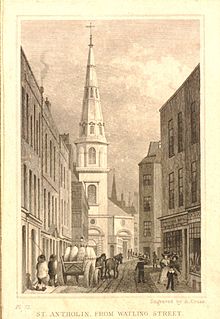St Antholin Watling Street
| St Antholin, Budge Row | |
|---|---|

St Antholin's, as rebuilt in the 17th century, Engraving c.1830 by A. Cruse after Thomas Hosmer Shepherd.
|
|
| Location | London |
| Country | United Kingdom |
| Denomination | Roman Catholic, Anglican |
| Architecture | |
| Demolished | 1874 |
St Antholin, Budge Row, or St Antholin, Watling Street, was a church in the City of London. Of medieval origin, it was rebuilt to the designs of Sir Christopher Wren, following its destruction in the Great Fire of London in 1666. The 17th-century building was demolished in 1874.
The church, which is first recorded in 1119, was on the north side of Budge Row(which no longer exists), at the corner of Sise Lane in Cordwainer Ward. It was originally known as St Anthony's, or St Anthonine's. It was dedicated to Saint Anthony the Great.
The church was "re-edified" at the expense of Sir Thomas Knowles (Mayor of London in 1399 and 1410) and his son, also called Thomas. Both were buried in the church. It seems to have been rebuilt again in 1513 by John Tate. It was repaired in 1616, at a cost of more than £900, and in 1623 a richly decorated gallery was added, its front divided into 52 panels, each bearing a coat of arms.
The church became noted for its early morning lectures, established in 1559, to announce which the bells would start to ring at 5 am.
St Antholin's was destroyed in the Great Fire of London in 1666, and rebuilt in 1678-84 by Sir Christopher Wren, at a cost of £5,685, paid for from the coal tax, and from contributions. The parish was united with that of St John the Baptist upon Walbrook, which was not rebuilt.
The new church was 66 feet (20 m) long and 44 feet (13 m) wide; the tower, to the top of its spire, was 154 feet (47 m) high. The exterior of the body of the church was plain in style, but the attached steeple was more unusual and elaborate:George Godwin, writing in the early 19th century said the tower and spire "although they might not be termed beautiful or pure, display great powers of invention, and are of pleasing proportions". The stone spire was octagonal in plan, divided into storeys by horizontal ribs, with circular ribs at the corners. There were openings at the base of the spire, and it was crowned with the head of a classical column of the Composite order.
The ceiling of the new church was in the form of an oval dome, supported on eight columns standing on high plinths. Godwin noted that "the carpentry of the roof displays Wren's knowledge of constructive science, and may be studied with advantage." There was a small gallery with an organ at the west end, and a circular window at the east end, above the altar.
...
Wikipedia
